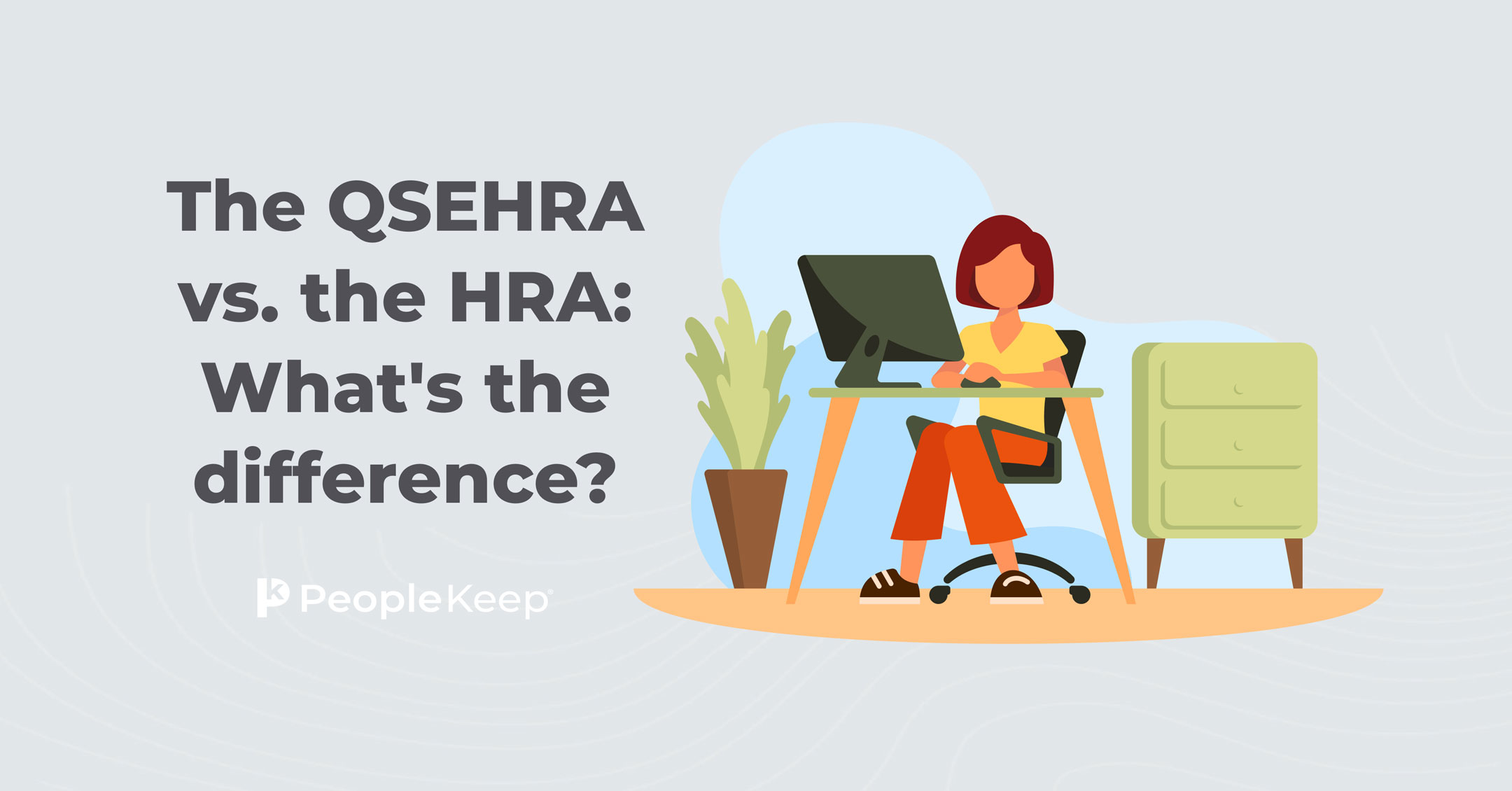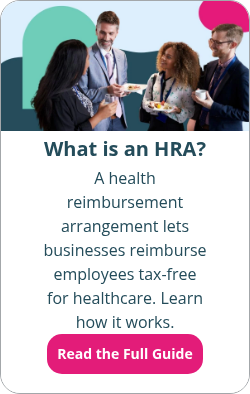The history of health reimbursement arrangements (HRAs)
By Elizabeth Walker on September 13, 2024 at 8:00 AM
Offering employer-sponsored health benefits in the U.S. dates back to World War II. Traditional group health insurance, which dates back to the early twentieth century, remains the most common type of employer-sponsored benefit. But, health reimbursement arrangements (HRAs), which are newer, have become more popular.
If you’re new to HRAs, you may wonder how this unique health benefit started. In this article, we’ll walk you through the history of HRAs and how they’ve changed over the years. We'll also explain why they’re an excellent option for both employers and employees.
In this blog post, you’ll learn:
- About the origins and development of HRAs.
- The changes in federal legislation that have changed HRAs.
- How HRAs compare with traditional group health coverage.
The beginnings of employer-sponsored healthcare
In the early 20th century, industrialization was booming. Most individuals worked in rough factory conditions, often leading to health problems. To better attract and keep workers, some employers provided onsite medical care. The employer funded and managed these company doctors. But, employee health coverage was basic and limited. Other unions and groups contracted with local hospitals during the Great Depression1.
By the 1940s, employer-based health plans became more popular. Employers would buy fully-insured group health policies from an insurance company. Self-insured policies gave employers more flexibility and control but at a greater risk. Regardless of how they were funded, group plans allowed employers to pay for their employees’ medical costs as a “defined benefit.”
In 1954, Congress created a new code allowing employers to deduct their contributions toward employee health coverage from their taxes2. Employees were also exempt from paying taxes on the value of their health insurance. The law also allowed employees to make pre-tax contributions to their premiums. These tax advantages made employer-sponsored healthcare a sought-after benefit for employers and employees.
The demand for healthcare reimbursements grow
By the 1960s, deductibles, cost-sharing, and limitations on covered medical services were common. To help employees pay for their out-of-pocket costs, some employers created “healthcare arrangements.” These arrangements reimbursed active employees for a wide range of qualified medical expenses their health plans didn’t cover. This concept eventually evolved into HRAs.
The federal government made such arrangements subject to the Employee Retirement Income Security Act of 1974 (ERISA) to ensure they met minimum standards3. ERISA applies to most employer-sponsored plans, including traditional group health insurance and HRAs. It ensures employers provide plan documents and outline employees’ rights regarding benefits.
These arrangements were also subject to the Health Insurance Portability and Accountability Act of 1996 (HIPAA). This law protects employees’ health information and privacy. Employers who violate HIPAA can face costly penalties.
Defined contribution health plans increase in popularity
By the late 1990s, defined contribution health plans had become popular among employees. With these plans, employers contributed a set amount of money toward an employee's out-of-pocket medical costs. Eligible expenses included individual health insurance premiums, emergency care, and preventive services.
With a defined contribution coverage plan, employers didn’t have to pay for an expensive group health policy. Instead, employees would choose their own health plan and out-of-pocket medical care. Then, employers would reimburse them for the costs. The flexibility of these plans gave employees more control over their healthcare choices.
Finally, healthcare reimbursement arrangements, like HRAs, had a designated benefit category.
The federal government defines HRAs
In the early stages of defined contribution health plans, they had few formal regulations. The federal government defined them in 2002 to make them more structured. This essentially created modern HRAs.
IRS Notice 2002-454 and Revenue Ruling 2002-415 outlined the following rules for HRAs:
- Only employers can fund the HRA—employees can’t contribute to it.
- HRAs can only reimburse employees for substantiated medical expenses outlined in IRS Section 213(d). The IRS provides additional guidance in Publication 5026. Employees can’t receive cash or any other benefits from the HRA.
- Unused HRA funds can carry over to later plan years. However, employers can limit annual rollovers if they choose.
- HRAs can reimburse employees for their health insurance plan premiums.
- Employers can use an HRA to reimburse former employees for qualified medical expenses. This includes retirees and COBRA beneficiaries.
- Employers can’t provide an HRA under a Section 125 cafeteria plan.
- Because HRAs are self-insured medical expense reimbursement plans, nondiscrimination rules and testing apply.
HRAs were now like other employee benefits that use a reimbursement model. Employees bought an eligible expense out-of-pocket and submitted their receipts to their employer. After the employer reviewed and approved the cost, they reimbursed the employee tax-free.
New legislation restricts HRAs
In 2013, IRS Notice 2013-54 limited businesses’ ability to offer HRAs7. In this notice, the IRS defined HRAs as group health plans. This meant they had to follow the Affordable Care Act (ACA) market reforms. Under the reforms, there were to be no annual dollar limits on essential health benefits, like prescription drugs and preventive care.
The IRS felt that HRAs couldn’t follow this rule because employer contributions were limited. They felt this was the case even though employees could buy a health plan without annual limits on the individual market. The notice also prohibited HRAs from integrating with individual health plan coverage.
Due to this new legislation, large employers could only offer a group coverage HRA (GCHRA). The IRS recognized GCHRAs in 2004. But they weren’t popular with small employers because they could only work with group plans. Many small business owners couldn’t afford a group plan or meet the participation requirements. This made GCHRAs an unsuitable option for them.
Many small employers also offered a “premium-only HRA” under the new rules. This HRA only reimburses employees for their monthly premiums—not other out-of-pocket costs. While controversial, many believed a premium-only HRA was acceptable under the new rules. This is because premium costs aren’t an essential health benefit. Zane Benefits, now PeopleKeep, led the way in helping organizations offer HRAs during this time.
These restrictions took away the flexibility and customization of HRAs. So, they were less attractive options for employers and employees.
The federal government lifts the restrictions, and a new HRA is born
Luckily, restrictions on HRAs didn’t last long. In 2016, the federal government passed the Small Business Healthcare Relief Act8. This Act reversed the limitations on HRAs caused by the 2013 notice. The 21st Century Cures Act of 2016 also created a new HRA—the qualified small employer HRA (QSEHRA)9.
Here are more details about how the QSEHRA works:
- The QSEHRA is only for employers with fewer than 50 full-time equivalent employees (FTEs) who don’t offer a group health plan.
- Employers define the monthly allowance they want to offer their employees. Like health savings accounts (HSAs), the IRS sets annual maximum limits. Employers can offer less than the limit in total monthly allowances, but they can’t exceed it.
- Employers must offer the QSEHRA equally to all their W-2 full-time employees. Part-time employees can join if they receive the same allowance as your full-time staff.
- Employees must have a health plan with minimum essential coverage (MEC) to use this HRA type.
- Employers can reimburse health insurance premiums only or premiums and qualified expenses. Allowances can vary by age or family status.
- Employees eligible for premium tax credits can still participate in the QSEHRA. If the IRS considers their allowance affordable, they must decline their tax credits. They must reduce the number of eligible credits by their allowance if it's unaffordable.
The simplicity and affordability of a QSEHRA make it an excellent solution for small businesses that want an alternative to traditional group health coverage. The HRA Council also found that employers who offer a QSEHRA have better employee retention and satisfaction10.
New legislation creates another new type of HRA
In October 2017, former President Donald Trump issued an executive order asking the Departments of the Treasury, Labor, and Health and Human Services to expand the availability and usability of HRAs.
The Departments responded with proposed regulations, finalizing them on June 13, 201911. The new rules created a new stand-alone HRA called the individual coverage HRA (ICHRA). It also created the excepted benefit HRA (EBHRA). As of 2024, employers are adopting an ICHRA at almost the same rate as a QSEHRA10.
Below are more highlights about the ICHRA:
- This type of HRA coverage is for organizations of any size.
- Employers can vary allowances by employee classes, such as part-time or full-time status.
- The ICHRA can’t coordinate with premium tax credits. Employees can opt in or out of the benefit based on affordability guidelines.
- Employees must have a qualified form of individual health insurance to participate in the benefit.
- Applicable large employers (ALEs) can design the ICHRA to fulfill the employer mandate.
On March 27, 2020, Congress signed the CARES Act into law. This Act added over-the-counter medicine and menstrual care products to the list of eligible medical expenses for HRAs.
The impact of HRAs is clear to business owners nationwide. According to the HRA Council’s 2024 report, 83% of employers couldn’t offer affordable health coverage without the ICHRA or QSEHRA10. With HRAs, employers can now provide health benefits that matter at a reasonable cost.
How PeopleKeep can help you offer an HRA
HRAs are an excellent alternative to group health insurance. They’re also the perfect way for small employers to offer benefits for the first time.
With PeopleKeep’s HRA administration software, businesses can offer the following types of HRAs:
PeopleKeep simplifies the complex process of offering an HRA. We handle everything from generating plan documents to reviewing employee reimbursement requests. This ensures employers can manage their benefits without the administrative burden. Plus, employees with a QSEHRA or ICHRA can enroll in a health insurance plan from within their PeopleKeep dashboard.
Conclusion
Thanks to HRAs, employers of all sizes can offer a quality, IRS-approved health benefit. They give employers the ability to control their budget and employees the freedom to choose their health coverage. Even though HRAs are simpler to manage than group plans, they still have regulations. Setting up and managing an HRA can be tricky if it’s your first time. That’s where PeopleKeep can help. Our HRA administration software can help you design your benefit so it complies with federal rules, saving you time and money. Book a demo with one of our HRA specialists today, and we’ll get you started.
This blog article was originally published on May 8, 2012. It was last updated on September 13, 2024.
Check out more resources
See these related articles

Types of HRAs
Explore the different types of HRAs, including ICHRA, QSEHRA, and group coverage HRA. Learn how each works and which is right for your organization.

HRAs and S corporation owners
While S-corporation owners can't participate in HRAs, they can still be a good option to offer to employees instead of traditional group insurance.

The QSEHRA vs. the HRA: What's the difference?
Confused about the difference between an HRA and a QSEHRA? This guide explains how a QSEHRA compares to other types of HRAs.



